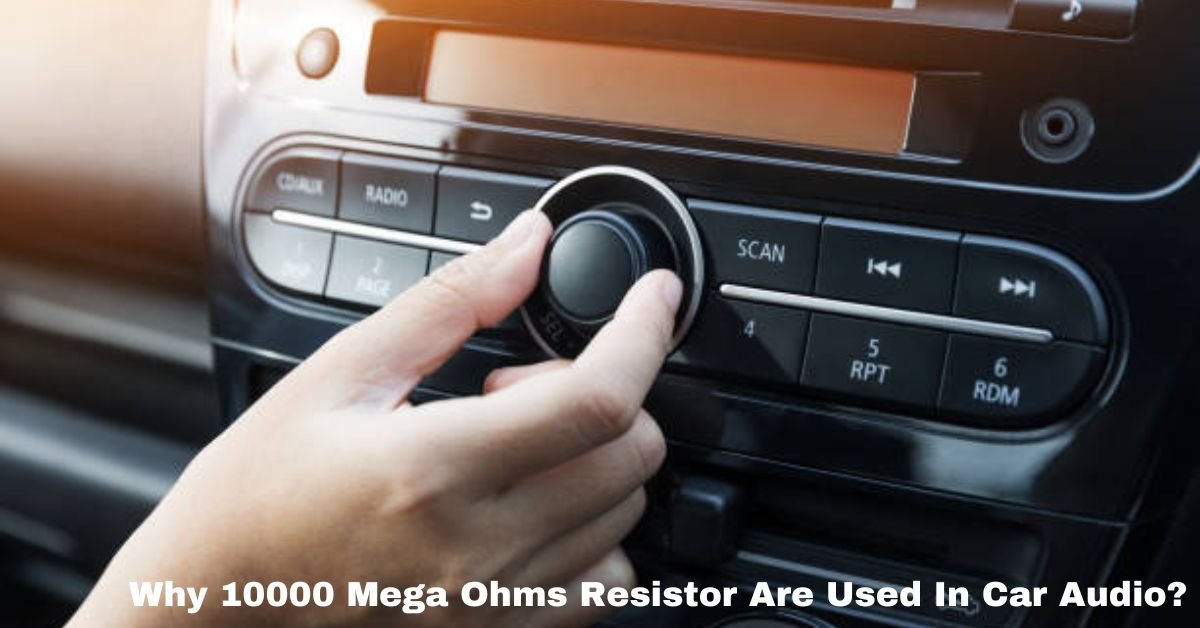Car audio systems are designed to deliver high-quality sound and performance, and the components inside these systems play a crucial role in achieving that goal. Among these components, resistors are essential for managing electrical current and ensuring that the audio system functions smoothly. One particular type of resistor that is often used in car audio systems is the 10,000 mega ohm (10MΩ) resistor. But why is this specific resistor used, and what makes it important in the context of car audio? Let’s dive into this topic and explore the significance of 10MΩ resistors in car audio applications.
Why 10,000 Mega Ohm Resistors Are Used in Car Audio Systems
1. What is a 10,000 Mega Ohm Resistor?
Before delving into why 10,000 mega ohm resistors are used in car audio, it’s important to understand what a 10MΩ resistor is and how it works. One million ohms is the equivalent of the “mega ohm” (MΩ), a unit of electrical resistance. A resistor with a resistance of 10,000 mega ohms is essentially a very high resistance component that limits the flow of electric current. This resistance can be crucial in controlling and regulating electrical signals in a circuit, preventing damage to sensitive components and ensuring optimal performance.
2. The Role of Resistors in Car Audio Systems
Car audio systems consist of several complex components, such as amplifiers, speakers, subwoofers, and crossovers, all of which require precise electrical signals to operate effectively. Resistors help to manage the flow of electrical current throughout these components, ensuring that each part of the system receives the appropriate signal strength. In audio systems, resistors are often used to:
- Limit the current: Too much current can damage sensitive audio components. Resistors help to limit the flow of current and protect the system from potential damage.
- Control voltage levels: Car audio systems rely on specific voltage levels to achieve the best sound quality. Resistors can adjust the voltage to match the required levels for different components.
- Filter signals: In some cases, resistors are used in combination with capacitors to filter out unwanted frequencies and noise, ensuring that the audio signal is as clear and distortion-free as possible.
Must Read: Which Volvo Maine Redblock Can I Use In a car?

3. Why 10,000 Mega Ohms?
Now that we know the basic functions of resistors in car audio, let’s explore why a 10,000 mega ohm resistor might be specifically chosen for use in certain parts of a car audio system.
- High Impedance in Signal Processing Car audio systems often use resistors with high impedance in the signal processing stages, such as preamps and crossovers. The 10MΩ resistor is particularly useful for handling weak signals, such as those coming from a radio or a low-level audio source. These resistors ensure that the signals are properly managed without affecting the quality of the sound or introducing distortion. The high resistance helps to avoid loading the audio signal too much, which could otherwise cause signal degradation or loss.
- Protection Against Voltage Spikes Car audio systems are often exposed to fluctuations in voltage, especially considering that modern vehicles can experience sudden power surges or drops due to engine startup, electrical interference, or other factors. The 10MΩ resistor acts as a protective barrier, absorbing any potential voltage spikes and preventing them from reaching more sensitive components, such as the amplifier or speakers. This protection is especially important because voltage spikes can cause irreversible damage to audio equipment if not properly managed.
- Preventing Ground Loops and Noise Ground loops are a common issue in car audio systems, often caused by differences in the grounding of various components. These loops can result in unwanted hums, buzzes, and other noise that interfere with the audio experience. A 10MΩ resistor can help to isolate the ground loop and reduce the chances of noise affecting the audio signal. By strategically placing these resistors in the right locations within the system, manufacturers can improve the overall sound quality and eliminate issues caused by interference.
- Temperature Stability and Longevity Car audio systems are typically used in environments that experience varying temperatures, ranging from hot summer days to cold winter nights. Resistors with high resistance values, like 10MΩ resistors, are often chosen for their temperature stability and ability to maintain their performance over time. This is crucial for ensuring that the audio system continues to perform at its best throughout the lifespan of the car, without the resistors degrading or malfunctioning due to temperature fluctuations.
- Specialized Circuit Applications In some specialized applications, such as in passive crossovers or signal attenuation circuits, a 10MΩ resistor may be used to create very specific electrical conditions. These resistors can help in designing circuits that need extremely high resistance values to function correctly, such as those used in signal isolation or filtering. In these cases, the 10MΩ resistor allows for precise control over the circuit’s behavior, enabling engineers to achieve the desired performance without introducing unwanted variables.
Conclusion
The use of 10,000 mega ohm resistors in car audio systems may seem like a small detail, but it plays an important role in ensuring the quality, reliability, and longevity of the system. These high-resistance components help manage signals, protect against voltage spikes, reduce noise, and maintain stable performance in challenging environments. While you may not always notice them working in the background, the presence of these resistors contributes significantly to the overall audio experience in your vehicle. Whether you’re an audiophile looking to upgrade your car’s sound system or simply curious about the technology that powers modern audio systems, understanding the role of components like the 10MΩ resistor is key to appreciating the complexity and precision involved in creating high-performance car audio systems.
